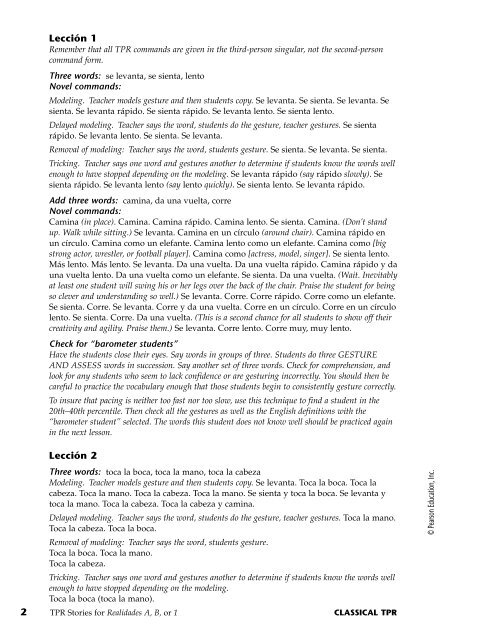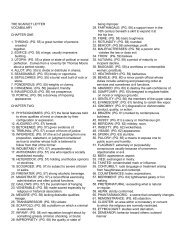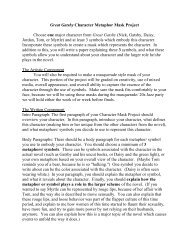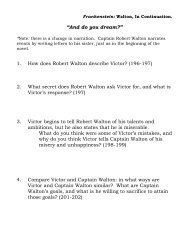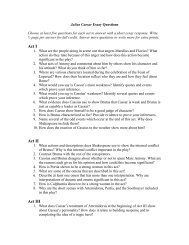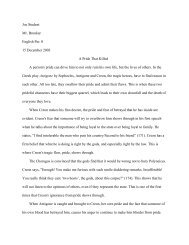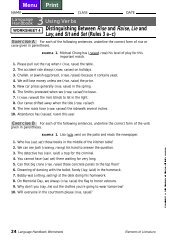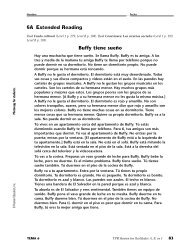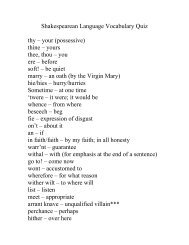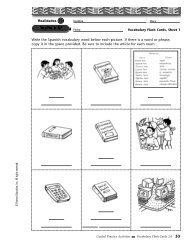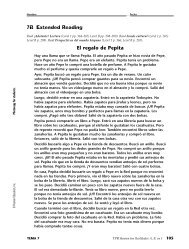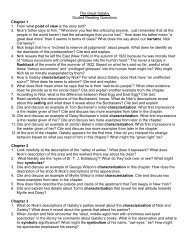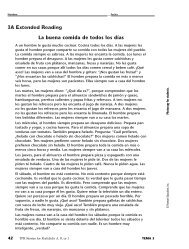You also want an ePaper? Increase the reach of your titles
YUMPU automatically turns print PDFs into web optimized ePapers that Google loves.
Lección 1<br />
Remember that all <strong>TPR</strong> comm<strong>and</strong>s are given in the third-person singular, not the second-person<br />
comm<strong>and</strong> form.<br />
Three words: se levanta, se sienta, lento<br />
Novel comm<strong>and</strong>s:<br />
Modeling. Teacher models gesture <strong>and</strong> then students copy. Se levanta. Se sienta. Se levanta. Se<br />
sienta. Se levanta rápido. Se sienta rápido. Se levanta lento. Se sienta lento.<br />
Delayed modeling. Teacher says the word, students do the gesture, teacher gestures. Se sienta<br />
rápido. Se levanta lento. Se sienta. Se levanta.<br />
Removal of modeling: Teacher says the word, students gesture. Se sienta. Se levanta. Se sienta.<br />
Tricking. Teacher says one word <strong>and</strong> gestures another to determine if students know the words well<br />
enough to have stopped depending on the modeling. Se levanta rápido (say rápido slowly). Se<br />
sienta rápido. Se levanta lento (say lento quickly). Se sienta lento. Se levanta rápido.<br />
Add three words: camina, da una vuelta, corre<br />
Novel comm<strong>and</strong>s:<br />
Camina (in place). Camina. Camina rápido. Camina lento. Se sienta. Camina. (Don’t st<strong>and</strong><br />
up. Walk while sitting.) Se levanta. Camina en un círculo (around chair). Camina rápido en<br />
un círculo. Camina como un elefante. Camina lento como un elefante. Camina como [big<br />
strong actor, wrestler, or football player]. Camina como [actress, model, singer]. Se sienta lento.<br />
Más lento. Más lento. Se levanta. Da una vuelta. Da una vuelta rápido. Camina rápido y da<br />
una vuelta lento. Da una vuelta como un elefante. Se sienta. Da una vuelta. (Wait. Inevitably<br />
at least one student will swing his or her legs over the back of the chair. Praise the student for being<br />
so clever <strong>and</strong> underst<strong>and</strong>ing so well.) Se levanta. Corre. Corre rápido. Corre como un elefante.<br />
Se sienta. Corre. Se levanta. Corre y da una vuelta. Corre en un círculo. Corre en un círculo<br />
lento. Se sienta. Corre. Da una vuelta. (This is a second chance for all students to show off their<br />
creativity <strong>and</strong> agility. Praise them.) Se levanta. Corre lento. Corre muy, muy lento.<br />
Check for “barometer students”<br />
Have the students close their eyes. Say words in groups of three. Students do three GESTURE<br />
AND ASSESS words in succession. Say another set of three words. Check for comprehension, <strong>and</strong><br />
look for any students who seem to lack confidence or are gesturing incorrectly. You should then be<br />
careful to practice the vocabulary enough that those students begin to consistently gesture correctly.<br />
To insure that pacing is neither too fast nor too slow, use this technique to find a student in the<br />
20th–40th percentile. Then check all the gestures as well as the English definitions with the<br />
“barometer student” selected. The words this student does not know well should be practiced again<br />
in the next lesson.<br />
Lección 2<br />
Three words: toca la boca, toca la mano, toca la cabeza<br />
Modeling. Teacher models gesture <strong>and</strong> then students copy. Se levanta. Toca la boca. Toca la<br />
cabeza. Toca la mano. Toca la cabeza. Toca la mano. Se sienta y toca la boca. Se levanta y<br />
toca la mano. Toca la cabeza. Toca la cabeza y camina.<br />
Delayed modeling. Teacher says the word, students do the gesture, teacher gestures. Toca la mano.<br />
Toca la cabeza. Toca la boca.<br />
Removal of modeling: Teacher says the word, students gesture.<br />
Toca la boca. Toca la mano.<br />
Toca la cabeza.<br />
Tricking. Teacher says one word <strong>and</strong> gestures another to determine if students know the words well<br />
enough to have stopped depending on the modeling.<br />
Toca la boca (toca la mano).<br />
2 <strong>TPR</strong> Stories for Realidades A, B, or 1 CLASSICAL <strong>TPR</strong><br />
© Pearson Education, Inc.


